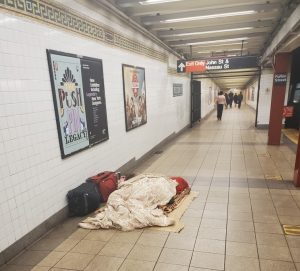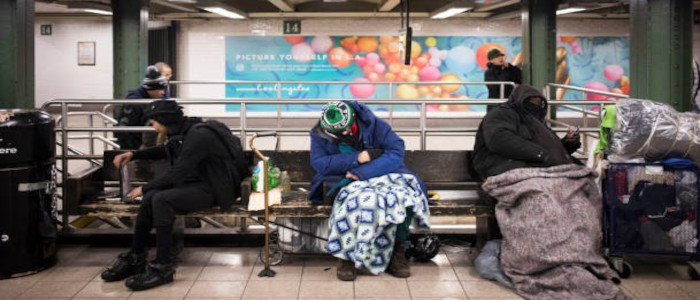“Home is a notion that only nations of the homeless
fully appreciate and only the uprooted comprehend.”
― Wallace Stegner, Angle of Repose
The basic needs that most people have, and others don’t, are taken for granted. What am I referring to? Why do I say this? Having a roof over my head with walls, floors, and doors, is not something I have to really think about. Why? Because I have that. No worries about where I will be safe and warm or eat my dinner. But what about the millions who don’t have that luxury?
I work near the Financial District in New York City, in the midst of the World Trade Center. During the summer months, as I walked from the train station to my workplace, I’d see individuals sitting on the street with written cardboard signs in front of them that read they were hungry and homeless. Going into McDonald’s for breakfast, there’d be a man holding the door open and asking for change. At every turn you’d see another.
Each night thousands of unsheltered homeless people sleep on New York City streets, in the subway system, and in other public spaces. Individuals living and sleeping on the street or in subways were not seen as much during the winter months. But as soon as the warm weather hit, out of nowhere, there they were. Now, as the warm weather begins to wane, many homeless people move into the subway environment for shelter…and oh, what a sight to see.
I take the train to work every day. From the starting point of my travel, at the foot of the station steps, a homeless person is asleep. When I get to my station stop in Manhattan – Fulton Street – and step onto the platform, I see a man sleeping on the station floor with no covering and no shoes. As I walk to the exit of the station, just a few feet away, there are two people covered up, asleep and laying side by side with all their belongings. It was at that moment that I felt the need to enlighten myself about the dark plight of street homelessness.
Homelessness can be identified in various ways, and in these days the look of the homeless has taken on a very different form. When I was growing up, the homeless person on the street was the “dirty bum,” “drunk” and the “down and out” population of men that lived in the Bowery, a neighborhood in lower Manhattan known as “Skid Row.” The area was notable for “Bowery Bums” — disaffected alcoholics and homeless persons. Believe me, homelessness in America is not a recent phenomenon. Let’s take a quick first look at homelessness.
History of Homelessness in America
There is a history of homelessness throughout U.S. history. During colonial times, English poor laws and Elizabethan attitudes about “worthy” and “unworthy” governed how communities responded to those in need and those without homes.
There were harsh settlement laws that informed who was allowed to join the community and who was forced to move on. The first documented cases of homelessness appear in colonial records from the 1640’s. European settlers were displacing Native Americans (imagine that) and resulting conflicts on the frontier also lead to homelessness among both Native Americans and Europeans.
In 1730, New York established its first “almshouse;” these were built by charitable organizations to shelter the poor. Almshouses and poor houses began opening across the colonies — many with rules and work requirements. During the Industrial Revolution and the transition to new manufacturing processes, there was mass migration to cities. This caused a new urban poverty that often resulted in homelessness. Economic downturns in the 1830’s and 1850’s caused many to lose their jobs and homes. During this stretch of time, tens of thousands of homeless people lived in police stations by night and in the streets by day.
Different Times, Same Problem
In recent years in New York City, where over 2,000 people live on the streets and the subway, homelessness has reached the highest levels since the Great Depression. Every night, nearly 4,000 people sleep on the street, in the subway system or in other public spaces. Eight of the city’s subway stations with the worst ongoing vagrancy problems saw homelessness spike nearly 45 percent over the summer. MTA chief safety officer Patrick Warren said that the eight stations — all but one in Manhattan — were being used as living quarters by an average of 14.7 people in August of 2021, up from 10.2 homeless people in May of 2021. One of those stations, I’m guessing, may include the Fulton Street station.
Why Can’t We Get a Handle on Homelessness?
Combating homelessness is very challenging, especially with those living on the streets. Getting a handle on the problem of homelessness is complicated because it is caused and perpetuated by many factors. In most cases, multiple factors are involved. Common ones include mental illness, substance abuse, untreated medical issues, traumatic events, violence and abuse, lack of affordable housing, and difficulty sustaining employment. Research shows that, compared to homeless families, homeless single adults have much higher rates of serious mental illness, addiction disorders, and other severe health problems.
With the rise in mental health crisis, drug and alcohol abuse, these images are spread throughout cities, states, and countries. It’s estimated that about two percent of the world’s population is homeless. This may not sound like a lot, but in mathematical terms, that’s nearly 154 million people living on the street, in temporary dwellings, at refugee camps, and in other transitory and often dangerous conditions. Add that to another billion people currently living without adequate shelter, it is believed that by 2050 that number will reach close to three billion. I’m trying to be optimistic about ending homelessness, but as I go to and from work, it looks as though the city is losing at easing homelessness.
Many say that boosting funding for housing programs is the solution. Of course, the end goal is always permanent housing. However, it’s not a “one size fits all.” We must meet people where they are to get them where they need to be. I’m talking about those with mental health issues or other crises. You can’t just make them go away or chase them from one spot to another. Viable solutions are needed that target every crisis that leads to homelessness and living/sleeping on the streets and in the subway system.
I read that New York City developed a solution that is replicated nationwide called Housing First. This program uses an approach to street homelessness which builds on the success of permanent supportive housing. It involves moving long-term street homeless individuals — the majority of whom are living with mental illness, substance abuse disorders and other serious health problems — directly into subsidized housing, and then linking them to support services, either on-site or in the community. This sounds like an excellent approach to me, but is it working?
While there are some skeptics, research studies have found that the majority of long-term street homeless people moved into “housing first” apartments remain stably housed and experience significant improvements in their health problems. The “housing first” approach is far less costly than emergency and institutional care, such as shelters, hospitals, and prisons. Perhaps some flaws exist, but the program seems more realistic in offering cross-services to address the multiple needs of individuals.
There has to be a way for the city to balance keeping the streets accessible for the rest of the population and, at the same time, moving people living on the streets and sleeping on the subway floors into a place that’s safe.
Source:
Giamo, Benedict, On the Bowery: confronting homelessness in American Society (University of Iowa Press) 1989.


















Add comment